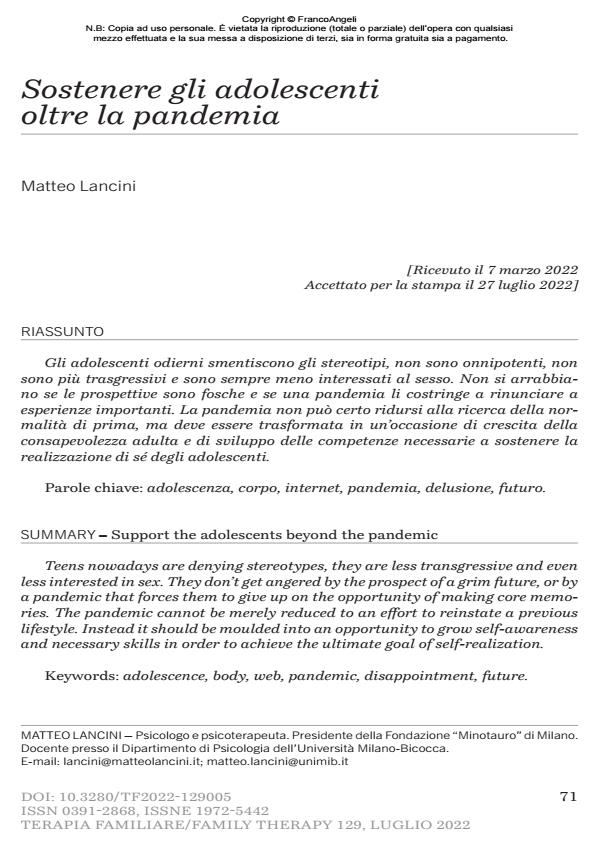Support the adolescents beyond the pandemic
Journal title TERAPIA FAMILIARE
Author/s Matteo Lancini
Publishing Year 2022 Issue 2022/129 Language Italian
Pages 18 P. 71-88 File size 640 KB
DOI 10.3280/TF2022-129005
DOI is like a bar code for intellectual property: to have more infomation
click here
Below, you can see the article first page
If you want to buy this article in PDF format, you can do it, following the instructions to buy download credits

FrancoAngeli is member of Publishers International Linking Association, Inc (PILA), a not-for-profit association which run the CrossRef service enabling links to and from online scholarly content.
Teens nowadays are denying stereotypes, they are less transgressive and even less interested in sex. They don’t get angered by the prospect of a grim future, or by a pandemic that forces them to give up on the opportunity of making core memories. The pandemic cannot be merely reduced to an effort to reinstate a previous lifestyle. Instead it should be moulded into an opportunity to grow self-awareness and necessary skills in order to achieve the ultimate goal of self-realization.
Keywords: adolescence, body, web, pandemic, disappointment, future.
- Pietropolli Charmet G. (2000). I nuovi adolescenti. Padri e madri di fronte a una sfida. Milano: Raffaello Cortina.
- AGIA – Autorità Garante per l’Infanzia e l’Adolescenza (2022). Pandemia, neuro- sviluppo e salute mentale di bambini e ragazzi. Documento di studio e proposta. In collaborazione con L’Istituto Superiore di Sanità. -- Disponibile online: https:// www.garanteinfanzia.org/pubblicazioni.
- Castaldo L., Serra G., Piga S., Reale A. & Vicari S. (2020). Suicidal behaviour and non-suicidal self-injury in children and adolescents seen at an Italian pediatric emergency department. Annali dell’Istituto Superiore di Sanità, 56(3): 303-314. DOI: 10.4415/ANN_20_03_08
- Cuzzocrea A. (2021). Che fine hanno fatto i bambini. Cronache di un paese che non guarda al futuro. Milano: Piemme.
- Eurispes (2018). Indagine Eurispes: sesso, erotismo e sentimenti, i giovani fuori dagli schermi.
- Grande E., Vichi M., Alicandro G., Simeoni S., Murianni L., Marchetti S., Zengarini N., Frova L. & Pompili M. (2021). Suicide among adolescents in Italy: a nationwi- de cohort study of the role of family characteristics. European child & adolescent psychiatry, 30(7): 1037-1045.
- Lancini M., a cura di (2019). Il ritiro sociale in adolescenza. La solitudine di una generazione iperconnessa. Milano: Raffaello Cortina.
- Lancini M., Cirillo L., Scodeggio T. & Zanella T. (2020). L’adolescente. Psicopatologia e psicoterapia evolutiva. Milano: Raffaello Cortina.
- Lancini M. (2021). L’età tradita. Oltre i luoghi comuni sugli adolescenti. Milano: Raffaello Cortina.
- McNair B. (1996). Mediated Sex. Pornograph and Postmodern Culture. London- New York: Arnold.
- Saito T. (1998). Shakaiteki hikikomori: owaranai shishunki [Social withdrawal: a neverending adolescence]. Tokio: PHP Shinsho.
- Siegel D. (2014). La mente adolescente. Milano: Raffaello Cortina.
Matteo Lancini, Sostenere gli adolescenti oltre la pandemia in "TERAPIA FAMILIARE" 129/2022, pp 71-88, DOI: 10.3280/TF2022-129005